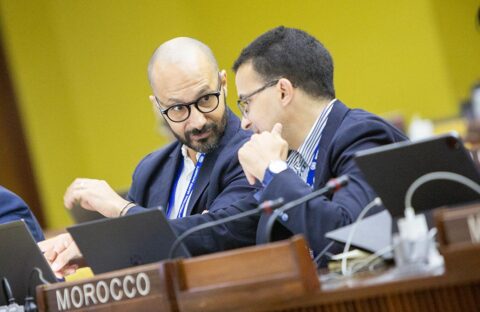The act calls for New York to obtain 70 percent of its electricity from renewable energy by 2030. But a leading business group and an influential GOP state senator want to go beyond pushing back deadlines and rewrite the law entirely.
This article previously appeared in WaterFront.
Gov. Hochul Ponders a Relaxation of Goals Under New York’s Landmark Climate Law
Climate Change
UN calls for faster emissions cuts for 2035 as first global estimate disappoints
Global greenhouse gas emissions are estimated to decline over the next decade but at a pace “still not nearly fast enough” to avoid the worst climate impacts, the UN’s top climate official warned as a partial assessment of new national climate plans was released.
UNFCCC Executive Secretary Simon Stiell said global emissions are expected to fall by around 10% by 2035 based on a preliminary assessment of new national climate targets (NDCs) announced by countries that produce nearly 60% of the world’s greenhouse gases.
The Intergovernmental Panel on Climate Change (IPCC) has said that countries should cut their emissions much more rapidly, with a 60% drop from 2019 required by 2035 to limit global warming to 1.5C.
“Ten years after we adopted the Paris Agreement, we can say simply – it is delivering real progress,” said Stiell. “But it must work much faster and fairer, and that acceleration must start now.”
Country delays hamper UN review
Countries are expected to discuss the shortfall in emissions-cutting ambition at next month’s COP30 summit in Belém, Brazil, but it is still unclear what form their response will take.
Stiell said COP30 needs to show nations are still fully on board for climate co-operation, as well as accelerating implementation across all economic sectors and connecting climate action to people’s lives.
But with only two weeks to go until leaders arrive in the Amazon city, most nations – including several big emitters – are yet to even publish an updated climate plan, known as a nationally determined contribution (NDC), after missing multiple deadlines, the last of which was September.
The delay caused a headache for the UN climate officials tasked with producing an official review of emission-cutting targets by the end of this month to inform discussions at COP30. That ‘synthesis report’ was released on Tuesday, alongside Stiell’s speech.
But its authors warned against drawing global conclusions from the numbers it contains because the analysis only covers the 64 countries – responsible for 30% of emissions – that formally submitted their NDCs by the end of September. Since then, a handful more have published their plans, including South Africa and Indonesia.
An update document is set to be published during COP30, when more NDCs should be submitted.
In the meantime, Stiell said the UN climate body (UNFCCC) did “some additional calculations” which, on top of formal NDC submissions, drew on 2035 targets touted by nations in various unofficial formats.
That includes, for example, China, which promised last month during a UN summit in New York to cut emissions by 7-10% from “peak levels”, and the European Union, which announced the bloc’s 2035 target would “range between 66% and 72%” below 1990 levels. Neither has yet published a full NDC.
This UNFCCC calculation, which unlike the synthesis report has not been published, showed that global emissions are projected to fall by 10% from 2019 levels by 2035.
US U-turn clouds global outlook
That headline figure hides a number of uncertainties. Emission-cutting trajectories can change when vague statements are translated into fully fleshed-out climate plans.
Additionally, the assessment includes the targets submitted by the United States – the world’s second largest emitter – in the final weeks of the Biden administration, which aim to cut emissions by 61-66% below 2005 levels by 2035.
But Donald Trump’s return to the White House has all but shredded that plan. The US president has axed climate policies and slashed funding for clean energy, alongside kicking off the process that will see the country leave the Paris Agreement at the start of next year.


State-level authorities and businesses are still likely to push on with some measures to reduce emissions, despite Washington’s pullback, but the extent to which those can help meet the NDC offered by the Biden administration is unclear.
In his speech on Tuesday, Stiell said those taking strong climate action will reap the rewards “measured in millions of new jobs and trillions in new investment”.
“We are still in the race, but to ensure a livable planet for all eight billion people today, we must urgently pick up the pace,” he added.
The post UN calls for faster emissions cuts for 2035 as first global estimate disappoints appeared first on Climate Home News.
UN calls for faster emissions cuts for 2035 as first global estimate disappoints
Climate Change
Asheboro, North Carolina, Is Under Pressure to Control Discharges of a Toxic Chemical Into Drinking Water Supply
The EPA wants the city of 28,000 to rein in an industrial solvent, 1,4-Dioxane, from its wastewater discharges. So far, Asheboro has refused.
ASHEBORO, N.C.—Some members of the public in attendance at the Environmental Protection Agency hearing last week called the City of Asheboro’s actions “despicable.” Others said they were “shameless.” And still another remarked that those who pollute the water—which data show Asheboro is doing—await “a special circle of hell.”
Climate Change
Can COP30 mark a turning point for climate adaptation?
Cristina Rumbaitis del Rio is a senior advisor on adaptation and resilience and Pan Ei Ei Phyoe is a climate adaptation and resilience consultant with the United Nations Foundation.
COP 30 compels the world to make a decision. Already 3.6 billion people are highly vulnerable to rapidly worsening climate impacts such as droughts, floods, and heat stress. Meanwhile, Glasgow-era climate finance commitments are expiring, and elements of the Global Goal on Adaptation (GGA) are yet to be finalized.
This November provides the opportunity to elevate the issue of adaptation and resilience – and for countries to demonstrate they grasp the urgency and are prepared to act.
Success at COP30 will hinge on how three key questions are answered:
- Will countries agree on a new adaptation finance target backed with real commitments?
- Will countries finalize architecture to track progress toward the Global Goal on Adaptation and implement the UAE Targets for Global Climate Resilience?
- Will adaptation receive elevated political attention at COP30?
A new adaptation finance target backed with real commitments
Belém will test whether negotiators can agree on a new adaptation finance goal that is anchored in clear targets, timelines, and accountability. The Glasgow Climate Pact’s goal to double adaptation finance is set to reach its deadline at the end of this year and countries are facing the question of what, if anything, comes next.
The form of the finance goal also matters: will it be a provision-based target ensuring measurable public contributions, or a mobilization target dependent on less transparent private leverage?
After two consecutive years of falling short, all eyes will be on whether the Adaptation Fund can finally meet its mobilization target and secure a multi-year replenishment to deliver predictable support.
Multilateral development banks (MDBs) are under pressure to demonstrate how to integrate adaptation into country-platform approaches including aligning finance for accelerated country-driven action and providing fast-start financing for implementation of National Adaptation Plans. NAPs have been completed by 67 developing countries and are underway in another 77 countries.
Climate adaptation can’t be just for the rich, COP30 president says
Vulnerable countries currently need an estimated $215 billion-$387 billion annually to adapt to climate change, far exceeding available funding. And developed countries face growing expectations to renew or grow their bilateral commitments beyond Glasgow-era pledges that are expiring this year or next.
Without tangible new finance commitments, the ambition of the Global Goal on Adaptation risks remaining rhetorical.
System to track progress on the Global Goal on Adaptation
The GGA still has no mechanism to measure progress, despite being established under the Paris Agreement in 2015, shaped through multiple work programs since 2021, and further expanded by the UAE Framework for Global Climate Resilience of COP28 which set 11 targets and launched the UAE-Belém Work Programme.
Agreeing on a robust, streamlined indicator set that is both scientifically sound and usable by countries with differing capacities will be one of the hardest tasks at COP 30. These outcomes will be a test of whether we can move from measuring resilience to building it.
Foreign aid cuts put adaptation finance pledge at risk, NGOs warn
Negotiators must settle the inclusion of equitable means-of-implementation indicators covering finance, technology, and capacity building. Finally, they must decide what comes next under the UN Framework Convention on Climate Change to ensure the UAE targets are acted upon within the next two to five years.
Those targets include seven that set resilience priorities for water and sanitation, food and agriculture, health, ecosystems, infrastructure, livelihoods and cultural heritage.
Adaptation needs greater political attention at COP30
Last week, COP30 President Corrêa do Lago released the first-ever COP presidency letter focused on elevating adaptation, calling for solutions that will make Belém the “COP of adaptation implementation”. His task now is to embed that principle across every strand of COP30’s delivery architecture.
One test lies in how realistically adaptation is integrated into the Baku-to-Belém Roadmap to $1.3 trillion to be released by the presidency. The implementation of the COP 30 Action Agenda, which provides a blueprint for collective climate action and solutions, could become the bridge between political vision and practical delivery on adaptation.
Questions remain on whether Brazil’s leadership on adaptation thus far will position adaptation as a political priority that will be reflected in leaders’ statements at the opening of COP30. The inaugural High-level Dialogue on Adaptation – hosted by the outgoing COP President Azerbaijan and Brazil – is another opportunity where countries can reaffirm and institutionalize adaptation as a permanent pillar of climate action.
In the role as the host and president of COP30, Brazil has repeatedly stressed the importance of matching adaptation with actual resources and accountability, highlighting adaptation as one of the five guiding stars of the Paris Agreement alongside mitigation, finance, technology, and capacity building.
With the right outcomes in Belém on finance targets, measurement systems, and political commitments, COP30 could be remembered as the moment adaptation financing and implementation finally matched the scale of the challenge.
The post Can COP30 mark a turning point for climate adaptation? appeared first on Climate Home News.
-
Climate Change2 years ago
Spanish-language misinformation on renewable energy spreads online, report shows
-
Climate Change3 months ago
Guest post: Why China is still building new coal – and when it might stop
-
Climate Change Videos2 years ago
The toxic gas flares fuelling Nigeria’s climate change – BBC News
-

 Greenhouse Gases1 year ago
Greenhouse Gases1 year ago嘉宾来稿:满足中国增长的用电需求 光伏加储能“比新建煤电更实惠”
-
Greenhouse Gases3 months ago
Guest post: Why China is still building new coal – and when it might stop
-

 Climate Change1 year ago
Climate Change1 year ago嘉宾来稿:满足中国增长的用电需求 光伏加储能“比新建煤电更实惠”
-

 Carbon Footprint2 years ago
Carbon Footprint2 years agoUS SEC’s Climate Disclosure Rules Spur Renewed Interest in Carbon Credits
-
Renewable Energy4 months ago
US Grid Strain, Possible Allete Sale





